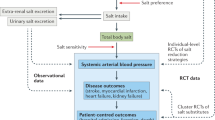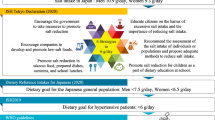Abstract
The United Kingdom has successfully implemented a salt reduction programme. We carried out a comprehensive analysis of the programme with an aim of providing a step-by-step guide of developing and implementing a national salt reduction strategy, which other countries could follow. The key components include (1) setting up an action group with strong leadership and scientific credibility; (2) determining salt intake by measuring 24-h urinary sodium, identifying the sources of salt by dietary record; (3) setting a target for population salt intake and developing a salt reduction strategy; (4) setting progressively lower salt targets for different categories of food, with a clear time frame for the industry to achieve; (5) working with the industry to reformulate food with less salt; (6) engaging and recruiting of ministerial support and potential threat of regulation by the Department of Health (DH); (7) clear nutritional labelling; (8) consumer awareness campaign; and (9) monitoring progress by (a) frequent surveys and media publicity of salt content in food, including naming and shaming, (b) repeated 24-h urinary sodium at 3–5 year intervals. Since the salt reduction programme started in 2003/2004, significant progress has been made as demonstrated by the reductions in salt content in many processed food and a 15% reduction in 24-h urinary sodium over 7 years (from 9.5 to 8.1 g per day, P<0.05). The UK salt reduction programme reduced the population’s salt intake by gradual reformulation on a voluntary basis. Several countries are following the United Kingdom’s lead. The challenge now is to engage other countries with appropriate local modifications. A reduction in salt intake worldwide will result in major public health improvements and cost savings.
This is a preview of subscription content, access via your institution
Access options
Subscribe to this journal
Receive 12 digital issues and online access to articles
$119.00 per year
only $9.92 per issue
Buy this article
- Purchase on Springer Link
- Instant access to full article PDF
Prices may be subject to local taxes which are calculated during checkout


Similar content being viewed by others
References
He FJ, Li J, Macgregor GA . Effect of longer term modest salt reduction on blood pressure: cochrane systematic review and meta-analysis of randomised trials. BMJ 2013; 346: f1325.
He FJ, MacGregor GA . Reducing population salt intake worldwide: from evidence to implementation. Prog Cardiovasc Dis 2010; 52: 363–382.
Aburto NJ, Ziolkovska A, Hooper L, Elliott P, Cappuccio FP, Meerpohl JJ . Effect of lower sodium intake on health: systematic review and meta-analyses. BMJ 2013; 346: f1326.
He FJ, MacGregor GA . Salt reduction lowers cardiovascular risk: meta-analysis of outcome trials. Lancet 2011; 378: 380–382.
D'Elia L, Rossi G, Ippolito R, Cappuccio FP, Strazzullo P . Habitual salt intake and risk of gastric cancer: a meta-analysis of prospective studies. Clin Nutr 2012; 31: 489–498.
He FJ, Marrero NM, MacGregor GA . Salt intake is related to soft drink consumption in children and adolescents: a link to obesity? Hypertension 2008; 51: 629–634.
Asaria P, Chisholm D, Mathers C, Ezzati M, Beaglehole R . Chronic disease prevention: health effects and financial costs of strategies to reduce salt intake and control tobacco use. Lancet 2007; 370: 2044–2053.
Bibbins-Domingo K, Chertow GM, Coxson PG, Moran A, Lightwood JM, Pletcher MJ et al. Projected effect of dietary salt reductions on future cardiovascular disease. N Engl J Med 2010; 362: 590–599.
National Institute for Health and Clinical Excellence (NICE). Guidance on the prevention of cardiovascular disease at the population level http://www.guidance.nice.org.uk/PH25, accessed 2013.
First global ministerial conference on healthy lifestyles and noncommunicable disease control, 28–29 April 2011, Moscow http://www.who.int/nmh/events/moscow_ncds_2011/en/, accessed 10 June 2013.
Beaglehole R, Bonita R, Horton R, Adams C, Alleyne G, Asaria P et al. Priority actions for the non-communicable disease crisis. Lancet 2011; 377: 1438–1447.
WHO issues new guidance on dietary salt and potassium, 31 January 2013 http://www.who.int/mediacentre/news/notes/2013/salt_potassium_20130131/en/, accessed 10 May 2013.
Sixty-sixth World Health Assembly, Follow-up to the Political Declaration of the High-level Meeting of the General Assembly on the Prevention and Control of Non-communicable Diseases. 25 May 2013 http://www.ncdalliance.org/sites/default/files/rfiles/A66_WHA%20Final%20Resolution.pdf, accessed 29 May 2013.
Food Standards Agency. Dietary sodium levels surveys, 22 July 2008 http://www.food.gov.uk/multimedia/pdfs/08sodiumreport.pdf, accessed 10 June 2013.
Department of Health: Assessment of Dietary Sodium Levels Among Adults (aged 19–64) in England, 2011 http://transparency.dh.gov.uk/2012/06/21/sodium-levels-among-adults/, accessed 25 June 2012.
Shankar B, Brambila-Macias J, Traill B, Mazzocchi M, Capacci S . An evaluation of the UK Food Standards Agency’s salt campaign. Health Econ 2013; 22: 243–250.
Millett C, Laverty AA, Stylianou N, Bibbins-Domingo K, Pape UJ . Impacts of a national strategy to reduce population salt intake in England: serial cross sectional study. PLoS One 2012; 7: e29836.
Wyness LA, Butriss JL, Stanner SA . Reducing the population's sodium intake: the UK Food Standards Agency's salt reduction programme. Public Health Nutr 2012; 15: 254–261.
Cardiovascular Review Group Committee. Report of the Cardiovascular Review Group Committee on Medical Aspects of Food Policy, Nutritional Aspects of Cardiovascular Disease. HMSO: London, UK, 1994.
Consensus Action on Salt and Health http://www.actiononsalt.org.uk/, access verified 23 July 2012.
MacGregor GA, Sever PS . Salt–overwhelming evidence but still no action: can a consensus be reached with the food industry? CASH (Consensus Action on Salt and Hypertension). BMJ 1996; 312: 1287–1289.
Godlee F . The food industry fights for salt. BMJ 1996; 312: 1239–1240.
Scientific Advisory Committee on Nutrition, Salt and health. 2003. The Stationery Office http://www.sacn.gov.uk/pdfs/sacn_salt_final.pdf, accessed 5 June 2013.
World Health Organization. Strategies to monitor and evaluate population sodium consumption and sources of sodium in the diet. 2010. http://www.who.int/dietphysicalactivity/reducingsalt/en/index.html, accessed 29 May 2013.
Henderson L, Irving K, Gregory J, Bates CJ, Prentice A, Perks J et al National Diet & Nutrition Survey: Adults aged 19 to 64 2003 3: pp 127–136 TSO: London, UK.
Effects of reducing salt in processed food on the population's salt intake - the salt model http://www.collections.europarchive.org/tna/20100927130941/; http://food.gov.uk/healthiereating/salt/saltmodel February 2005 (accessed 7 June 2012).
Salt reduction targets: March 2006. London, UK: Food Standards Agency, 2006. Available at http://www.food.gov.uk/multimedia/pdfs/salttargetsapril06.pdf, accessed 17 August 2012.
Girgis S, Neal B, Prescott J, Prendergast J, Dumbrell S, Turner C et al. A one-quarter reduction in the salt content of bread can be made without detection. Eur J Clin Nutr 2003; 57: 616–620.
Department of Health. Targets https://www.responsibilitydeal.dh.gov.uk/wp-content/uploads/2012/01/Salt-Targets-for-Responsibility-Deal.pdf, accessed 10 June 2013.
James WP, Ralph A, Sanchez-Castillo CP . The dominance of salt in manufactured food in the sodium intake of affluent societies. Lancet 1987; 1: 426–429.
Food Standards Agency. Traffic light labelling, Signposting http://www.food.gov.uk/foodlabelling/signposting/, accessed 10 June 2013.
Citizens’ forums on food: Front of Pack (FoP) Nutrition Labelling http://www.food.gov.uk/multimedia/pdfs/citforumfop.pdf, access 10 June 2013.
Department of Health, Single system for nutrition labelling announced, 24 October 2012 https://www.gov.uk/government/news/single-system-for-nutrition-labelling-announced, accessed 29 May 2013.
Food Standards Agency health campaign to reduce salt levels and save lives http://www.food.gov.uk/news/pressreleases/2004/sep/saltcampaignpress, accessed 10 June 2013.
Food Standards Agency—UK salt reduction initiatives http://www.food.gov.uk/multimedia/pdfs/saltreductioninitiatives.pdf, accessed 10 June 2013.
Salt in UK ready meals 45% lower than four years ago, Consensus Action on Salt and Health (CASH), 23rd November 2007 http://www.actiononsalt.org.uk/news/surveys/2007/ready/index.html, accessed 17 July 2012.
National Diet and Nutrition Survey: Headline results from Years 1 and 2 (combined) of the rolling programme 2008/9–2009/10 http://www.dh.gov.uk/en/Publicationsandstatistics/Publications/PublicationsStatistics/DH_128166, accessed 16 August 2012.
Brinsden HC, He FJ, Jenner KH, MacGregor GA . Surveys of the salt content in UK bread: progress made and further reductions possible. BMJ Open 2013; 3: e002936.
CASH Surveys. Consensus Action on Salt and Health http://www.actiononsalt.org.uk/news/surveys/2007/ready/index.html, accessed 17 May 2013.
Sutherland J, Edwards P, Shankar B, Dangour AD . Fewer adults add salt at the table after initiation of a national salt campaign in the UK: a repeated cross-sectional analysis. Br J Nutr 2013; 110: 552–558.
Department of Health: Salt strategy beyond 2012 https://www.responsibilitydeal.dh.gov.uk/wp-content/uploads/2013/03/Salt-Strategy-Beyond-2012.pdf, accessed 17 May 2013.
Barton P, Andronis L, Briggs A, McPherson K, Capewell S . Effectiveness and cost effectiveness of cardiovascular disease prevention in whole populations: modelling study. BMJ 2011; 343: d4044.
Ofcom, Office of Communications. Impact assessment http://www.stakeholders.ofcom.org.uk/binaries/consultations/foodads_new/ia.pdf, access verified 13 July 2010.
Department of Health. New salt strategy to drive further progress to cut salt https://www.responsibilitydeal.dh.gov.uk/salt-strategy/, accessed 12 May 2013.
Department of Health, Responsibility Deal - http://www.dh.gov.uk/en/Publichealth/Publichealthresponsibilitydeal/index.htm, accessed 10 June 2013.
Bryden A, Petticrew M, Mays N, Eastmure E, Knai C . Voluntary agreements between government and business - a scoping review of the literature with specific reference to the Public Health Responsibility Deal. Health Policy 2013; 110: 186–197.
Blais CA, Pangborn RM, Borhani NO, Ferrell MF, Prineas RJ, Laing B . Effect of dietary sodium restriction on taste responses to sodium chloride: a longitudinal study. Am J Clin Nutr 1986; 44: 232–243.
Food Service and Eating Out: An Economic Survey. Surveys, Statistics and Food Economics Division, January 2007 http://www.archive.defra.gov.uk/evidence/economics/foodfarm/reports/documents/Food%20service%20paper%20Jan%202007.pdf, accessed 24 July 2012.
Department of Health Responsibility Deal, 27 July 2012 http://www.responsibilitydeal.dh.gov.uk/2012/07/27/good-progress-on-salt-reduction/, accessed 27 July 2012.
Statement on Scottish Government announcement on Food Standards Agency, 27 June 2012 http://www.food.gov.uk/news-updates/news/2012/jun/scotgov, accessed 27 July 2012.
World Action on Salt and Health. Press release - Medical experts launch global campaign against salt to prevent over 2.5 million deaths worldwide each year http://www.worldactiononsalt.com/media/Media_coverage/Archive_Wash_Launch.htm, access verified May 28 2010.
Dunford E, Webster J, Woodward M, Czernichow S, Yuan WL, Jenner K et al. The variability of reported salt levels in fast foods across six countries: opportunities for salt reduction. CMAJ 2012; 184: 1023–1028.
Bech-Larsen T, Aschemann-Witzel JA . Macromarketing perspective on food safety regulation: the Danish ban on trans-fatty acids. J Macromarketing 2012; 32: 208–219.
Brownell KD, Warner KE . The perils of ignoring history: big tobacco played dirty and millions died. How similar is Big Food? Milbank Q 2009; 87: 259–294.
Webster JL, Dunford EK, Hawkes C, Neal BC . Salt reduction initiatives around the world. J Hypertens 2011; 29: 1043–1050.
Author information
Authors and Affiliations
Corresponding author
Ethics declarations
Competing interests
FJH is a member of Consensus Action on Salt & Health (CASH) and World Action on Salt & Health (WASH). Both CASH and WASH are non-profit charitable organisations and FJH does not receive any financial support from CASH or WASH. GAM is Chairman of Blood Pressure UK (BPUK), Chairman of CASH and Chairman of WASH. BPUK, CASH and WASH are non-profit charitable organisations. GAM does not receive any financial support from any of these organisations. HCB was an employee of CASH while working on the manuscript.
Rights and permissions
About this article
Cite this article
He, F., Brinsden, H. & MacGregor, G. Salt reduction in the United Kingdom: a successful experiment in public health. J Hum Hypertens 28, 345–352 (2014). https://doi.org/10.1038/jhh.2013.105
Received:
Revised:
Accepted:
Published:
Issue Date:
DOI: https://doi.org/10.1038/jhh.2013.105
Keywords
This article is cited by
-
Eating habit of adding salt to foods and incident sleep apnea: a prospective cohort study
Respiratory Research (2023)
-
Fifty shades of partnerships: a governance typology for public private engagement in the nutrition sector
Globalization and Health (2023)
-
Perceptions, barriers and enablers of salt reduction in Malaysian out-of-home sectors (MySaltOH): from the point of view of policy-makers and food industries
Health Research Policy and Systems (2023)
-
Changes in sodium levels in Australian packaged foods between 2014 and 2019: an interrupted time series analysis of the impact of the Victorian Salt Reduction Partnership’s media advocacy strategy
International Journal of Behavioral Nutrition and Physical Activity (2023)
-
The time trend of information seeking behavior about salt reduction using Google Trends: infodemiological study in Japan
Hypertension Research (2023)



